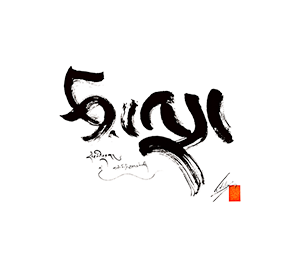Verse II.33 Variations
आर्यैश्च सूतिकामध्यस्थित बालार्कबिम्बवत्
āryaiśca sūtikāmadhyasthita bālārkabimbavat
།བྱིས་པས་དེ་སྔོན་མཐོང་མ་མྱོང་།
།བཙས་པའི་ཁྱིམ་ནས་བུ་ཆུང་གིས།
།ཉི་མའི་གཟུགས་བཞིན་འཕགས་པས་ཀྱང་།
Just as those born blind [have never seen] form.
Even noble ones [see it only] as an infant [would glimpse]
The orb of the sun while lying in the house of a new mother.
- De même que les aveugles de naissance ne voient pas les formes,
- Les êtres puérils ne l’ont jamais vue. Les êtres sublimes eux-mêmes
- Sont pareils à des nourrissons qui entrevoient la forme du soleil
- Depuis la chambre où ils viennent de naître.
RGVV Commentary on Verse II.33
Tibetan
English
Sanskrit
Chinese
Full Tibetan Commentary
Full English Commentary
Full Sanskrit Commentary
Full Chinese Commentary
Other English translations
Obermiller (1931) [7]
- Indeed, as the visible forms for those that are born blind,
- It is not accessible to the perception of ordinary beings;
- And even to the Saints who, though they perceive it (a little),
- Are with respect to it like new-born infants
- Perceiving the sun from the house where they are kept.
Takasaki (1966) [8]
- Because it has never been seen before by ordinary persons,
- Like the visible forms for those who are born blind, nor even by the Saints,
- Like the disk of the sun for infants lying in their mother's bed.
Fuchs (2000) [9]
- Why [is it hard to realize]? Like the blind with regard
- to the visible, the children have never seen it before.
- Even noble ones [see it] as babies [would glimpse]
- the sun from within the house where they are born.
Textual sources
Commentaries on this verse
Academic notes
- Digital Sanskrit Buddhist Canon Unicode Input
- Digital Sanskrit Buddhist Canon Unicode Input
- Brunnhölzl, Karl. When the Clouds Part: The Uttaratantra and its Meditative Tradition as a Bridge between Sūtra and Tantra. Boston: Snow Lion Publications, an imprint of Shambhala Publications, 2014.
- VT (fol. 14r6) glosses "the three wisdoms" as "those of study, reflection, and meditation" and "people with wisdom" as "śrāvakas, pratyekabuddhas, and bodhisattvas."
- VT (fol. 14r7) glosses °madhya° as °sthāna°, while Takasaki suggests the reading °sudma° instead of °madhya° (DP khyim).
- Skt. mṛdukarmaṇyabhāvāt. DP read "since it is nondual and workable" (gnyis med las su rung ba’i phyir).
- Obermiller, E. "The Sublime Science of the Great Vehicle to Salvation Being a Manual of Buddhist Monism." Acta Orientalia IX (1931), pp. 81-306.
- Takasaki, Jikido. A Study on the Ratnagotravibhāga (Uttaratantra): Being a Treatise on the Tathāgatagarbha Theory of Mahāyāna Buddhism. Serie Orientale Roma 33. Roma: Istituto Italiano per il Medio ed Estremo Oriente (ISMEO), 1966.
- Fuchs, Rosemarie, trans. Buddha Nature: The Mahayana Uttaratantra Shastra. Commentary by Jamgon Kongtrul and explanations by Khenpo Tsultrim Gyamtso. Ithaca, N. Y.: Snow Lion Publications, 2000.
